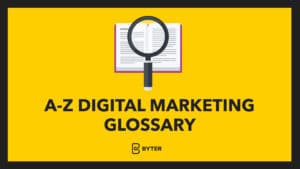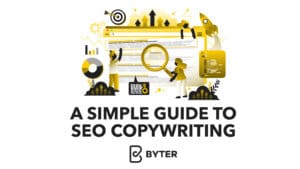A-Z Digital Marketing Glossary
Whether you’re a newbie to the field or are an experienced digital marketer in need of a refresher, getting the lingo down can be tough. That’s why we’ve created this handy digital marketing glossary from A-Z of the most useful buzzwords all digital marketers need to know.
Audience
The demographic you are targeting your ads at in order to convert them into customers.
Backlink
A link that connects one website to another. Also called “inbound links” and are very important SEO tools.
CTA – Call to Action
A word or phrase used in content to persuade the audience to perform a specific action, e.g. “buy now”
Domain Name
Part of a URL that identifies it as belonging to a particular company or organisation. E.g. in www.byter.com, the domain name is ‘byter.com’
Email List
A collection of emails used in email marketing. Each email address may represent a potential customer, business or outreach lead.
Full-Stack Developer
A web developer or engineer who is capable of producing both client and server software. They work with both the front and back end of a website or application.
Google Analytics
A web analytics service provided by Google that tracks and measures website metrics such as which search engine was used to land on the site, where users are located, how many users have visited the site, how long they stayed on each page, and more.
Hashtags
A metadata tag that is prefaced by the hash symbol, #. Hashtags are used for widespread content sharing, usually on social media platforms such as Instagram and Twitter.
Impressions
Impressions measure how often your ad is viewed on-screen by members of your audience.
Java Script
A programming language primarily used for building interaction-based applications on websites or digital devices.
Keyword
A word or phrase that is entered into a search engine. For the purpose of digital marketing, keywords are popular/ common words or phrases that are used in content to optimise a site’s ranking position.
Lead
A lead is a potential customer, someone who may potentially or may have already shown interest in your product or services.
Marketing Automation
Technology used for the purpose of streamlining marketing efforts to make them more effective.
NoFollow
An identifier tag that tells search engines not to increase the ranking of the webpage it is assigned to.
Organic Listing
A natural or unpaid listing of a website on a search result page. The point of SEO is to optimise organic listings.
PPC – Pay Per Click
An advertising method where advertisers will only pay for their adverts each time a user clicks on them.
Quality Score
A metric used by Google, Yahoo and Bing! To measure the quality of ads.
ROI – Return On Investment
Measures the return on an investment relative to its cost. In digital marketing, calculating the ROI will tell you whether marketing and campaign efforts are contributing to revenue growth.
SEO – Search Engine Optimisation
Increasing the quantity and quality of traffic to your website through organic search engine results. For example, practising SEO can increase the visibility of your website on google search results.
Traffic
Number of visitors to a website.
URL – Uniform Resource Locator
A web page address. E.g. www.byter.com is the address for Byter’s website.
Vlog
A video blog.
White Paper
An in-depth report or authoritative guide that educates an audience about a particular issue or problem.
XML Sitemap
A list of URL’s for a particular website. It is used by search engine crawlers to easily identify all of a website’s available content.
Youtube
An online video sharing platform.
And for Z….well, we’re not sure there is one. Please let us know if you have one!
Good luck!










